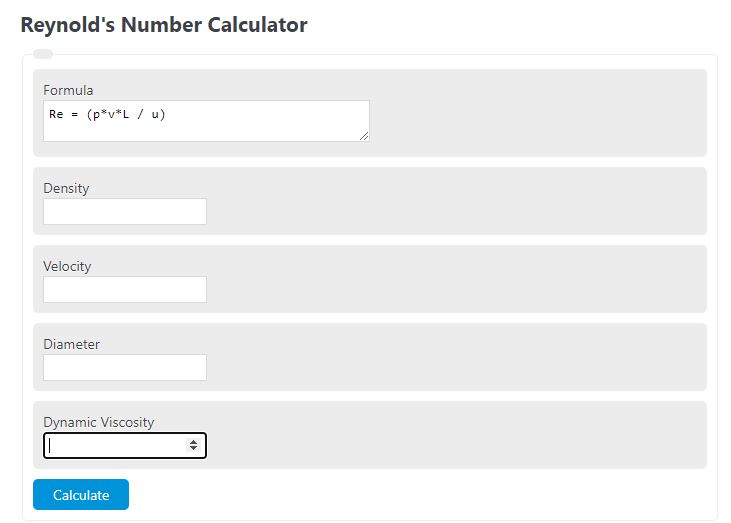Enter the density, flow speed, characteristic linear dimension, and dynamic viscosity of a fluid to determine the Reynold’s number.
- Dynamic Viscosity Calculator
- Prandtl Number Calculator
- Friction Factor Calculator
- Drag Coefficient Calculator
- Y+ Calculator
- Critical Velocity Calculator
- Settling Velocity Calculator
Reynolds Number Formula
The following formula is used to calculate a Reynolds number.
Re = (p*v*L / u)
- Where Re is Reynold’s number
- p is the density of the fluid
- v is the flow speed of the fluid
- L is the diameter of the tube
- u is the dynamic viscosity of the fluid
To calculate the Reynolds number, multiply the density, flow speed, and diameter, then divide by the dynamic viscosity.
Reynolds Number Definition
Reynold’s number is a unitless factor that describes the ratio of inertial forces to viscous forces of an object moving through a fluid or gas.
Reynolds Number Example
How to calculate Reynolds number.
- First, determine the density.
For this example, we will say the density is 100 slugs/ft^3.
- Next, determine the diameter of the tube.
The diameter is found to be 5 ft.
- Next, determine the flow velocity.
For this example the velocity is found to be 10 ft/s.
- Next, determine the viscosity.
Using the calculator above, the viscosity is found to be 10 lb-s/ft^2.
- Finally, calculate the Reynold’s Number.
Using the formula we find the Reynolds number to be 100*5*10/10 = 500. This is a laminar flow.
FAQ
Reynold’s Number is a dimensionless number that represents the ratio of the inertial forces to viscous forces acting on a fluid that is moving through an area, most often a tube.
Reynold’s number is used to classify whether fluids are moving in a laminar or turbulent flow. A number less than 2100 indicates laminar and a number greater than 2100 indicates turbulent flow.
Laminar flow is flow described as viscous flow in which the liquid flows along the lays of a tube without causing eddies or turbulence.

